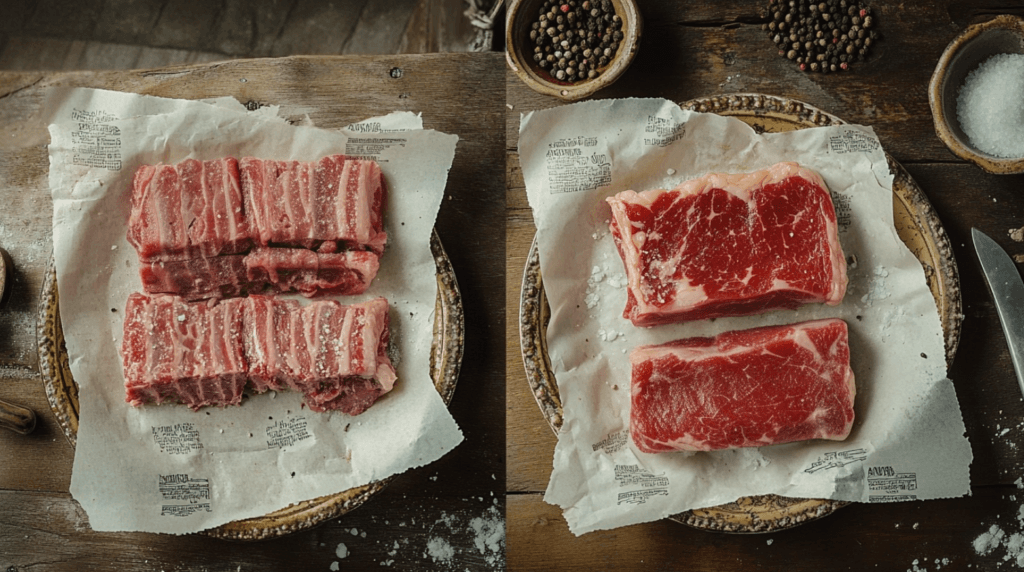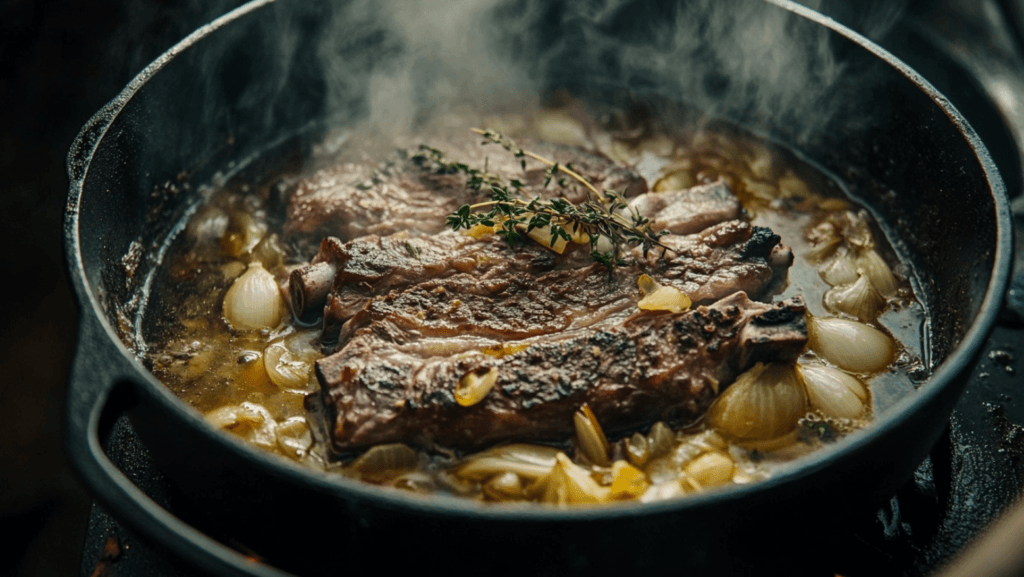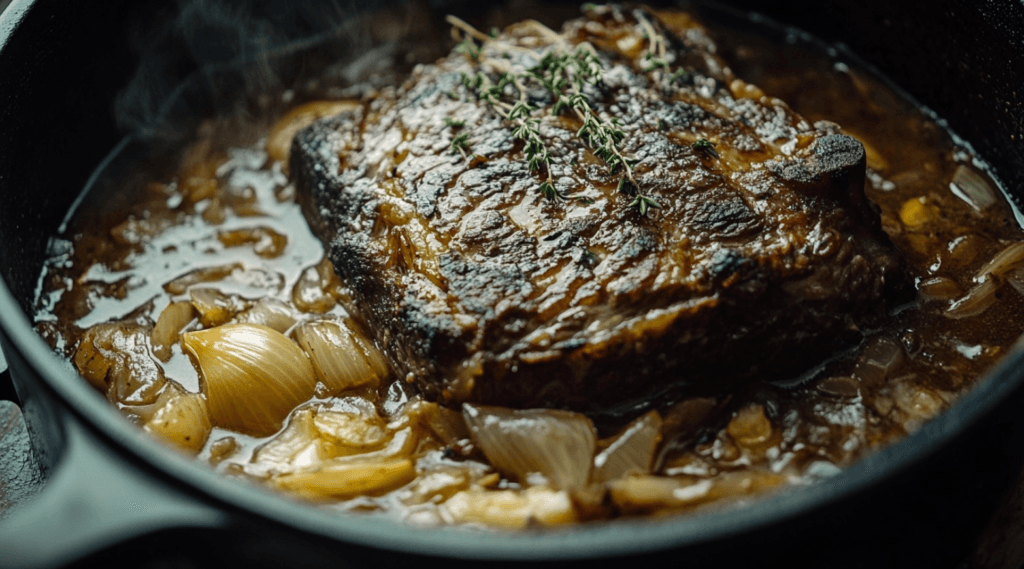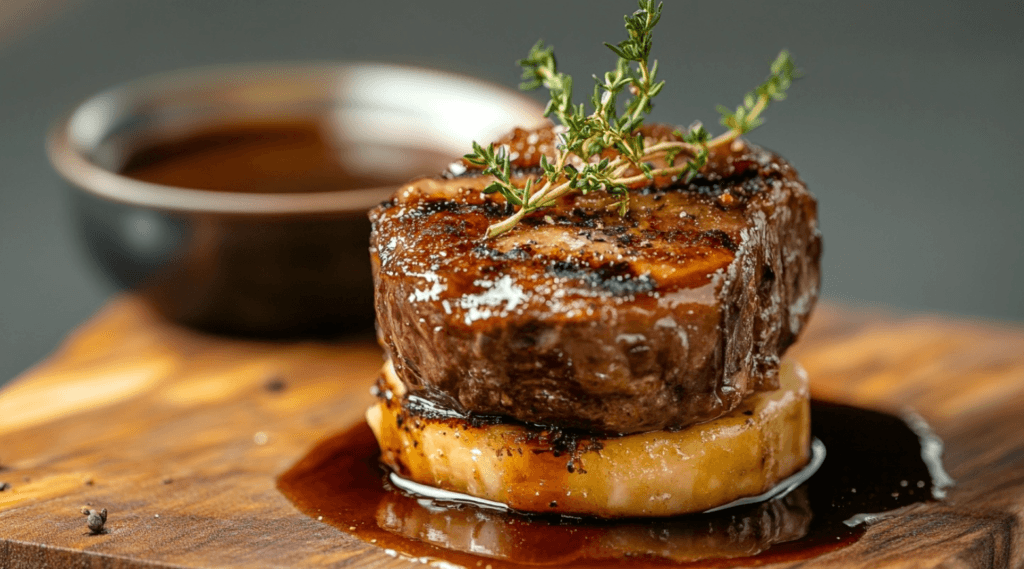I love cooking at home and exploring different cuts of beef ribs. From the tender back ribs to the flavorful short ribs, each has its own taste. But, boneless beef ribs and short ribs can seem similar. In this guide, we’ll look at the differences, cooking methods, and tastes to help you enjoy these cuts.
Understanding the Anatomical Difference Between Boneless and Bone-in Short Ribs
Short ribs come from two main parts of the beef: the chuck and the plate. These areas give each cut its own taste and texture. Knowing where they come from helps you choose the right one for your dish.
Chuck Cut vs. Plate Cut Origins
Chuck short ribs are from the shoulder. They are tougher because of more muscle. Plate short ribs, from below the brisket, are fattier and tenderer.
Muscle Structure and Composition
Chuck short ribs have a tough muscle texture. They need longer cooking to soften. Plate short ribs are quicker to cook and stay juicy.
Fat Distribution Patterns
Fat in short ribs affects taste and cooking. Plate short ribs have more fat inside, making them moist and flavorful. Chuck short ribs have less fat but still taste good.
Knowing the differences helps you pick the best short ribs for your meal. This ensures your beef is tasty and enjoyable.

Are Boneless Beef Ribs the Same as Short Ribs: A Detailed Comparison
Beef ribs come in different types. Boneless beef ribs and short ribs are two of them. They come from the same area but are not the same. Let’s look at the differences between these two cuts.
Boneless beef short ribs are from the chuck section but without bones. They are called short ribs because they come from the rib area. But they are shorter than traditional short ribs. This makes them easier to cook and more versatile.
Bone-in short ribs, on the other hand, come from the plate section below the rib cage. They keep their bone structure. This affects how they cook and taste. Both types are great for slow cooking, making the meat tender and flavorful.
| Boneless Beef Ribs | Bone-in Short Ribs |
|---|---|
| Cut from the chuck section | Cut from the plate section |
| Bones removed | Bone-in structure retained |
| Easier to prepare and cook | Require longer cooking time due to bones |
| More versatile in cooking methods | Best suited for slow-cooking techniques |
In summary, boneless beef ribs and short ribs are similar but different. They have different structures and cooking needs. Knowing these differences helps you choose the right one for your cooking.
The Truth About Boneless Short Ribs: Location and Cut
Boneless short ribs might sound odd, but they’re a special cut of beef. They come from the chuck section, specifically the serratus ventralis muscle. This muscle runs from the ribs to the shoulder blade.
This is why they’re called “short ribs,” even though they’re from the chuck, not the rib primal.
Serratus Ventralis Muscle Explained
The serratus ventralis muscle is well-marbled. This makes boneless short ribs flavorful and tender when slow-cooked. This muscle helps move the shoulder blade.
Its location in the chuck section makes boneless short ribs unique.
Why They’re Called Short Ribs Despite Coming from Chuck
The name “boneless short ribs” can be confusing. They’re not from the rib primal like traditional short ribs. But, they’re cut from the serratus ventralis muscle near the ribs.
This is why they’re still called “short ribs,” even though they come from the chuck.
Knowing where boneless short ribs come from is important. It helps you cook them perfectly. Whether braising, smoking, or roasting, understanding their origin unlocks their full flavor.

Cooking Time and Temperature Differences
Cooking beef ribs can take different times and temperatures based on the cut. Knowing these details is key to getting your ribs just right.
Oven Braising: For bone-in short ribs, cook at about 325°F (163°C). They need about 3 hours to become tender.
Smoking on a BBQ: Smoke the ribs at 225-250°F (110-121°C). Cook for 3-4 hours until the meat hits 200-205°F (93-96°C).
The thickness of the ribs affects cooking time. Here’s a rough guide:
- 1-inch thick ribs: About 4 hours to cook
- 1.5-inch thick ribs: About 6 hours to cook
- 2-inch thick ribs: About 8 hours to cook
Let the ribs rest for 10-15 minutes before serving. This makes them more flavorful and tender.
| Cooking Method | Temperature | Cooking Time |
|---|---|---|
| Oven Braising | 325°F (163°C) | Approximately 3 hours |
| Smoking on a BBQ | 225-250°F (110-121°C) | 3-4 hours |
For perfect beef ribs, watch the temperature and adjust cooking time. This way, you’ll make beef ribs cooking that everyone will love.
Flavor Profile Analysis: Bone-in vs. Boneless
The choice between bone-in and boneless ribs affects beef flavor a lot. Bone-in ribs have a deeper flavor because of marrow and other tasty elements in the bone. The marbling in the meat also matters a lot. It makes the meat juicier and more flavorful, whether it’s bone-in or boneless.
The texture of bone-in ribs and boneless ribs is different too. Boneless cuts are usually more even in texture. But bone-in cuts can have different textures near the bone. The meat near the bone is often tender and juicy.
Cooking methods also change the ribs’ texture and flavor. Slow-cooking, like braising, makes both types of ribs taste better.
Impact of Marbling on Taste
Marbling in meat is key for beef flavor and meat texture. Meat with more marbling is juicier and tastes better. The fat in the marbling melts while cooking, making the meat taste richer.
Meat with less marbling might be drier and less tasty. It might need extra cooking or seasoning to taste good.
Texture Variations Between Cuts
The texture of bone-in ribs and boneless ribs is different. Boneless cuts are more even in texture. But bone-in ribs can have different textures near the bone.
The meat near the bone is often tender and juicy. Cooking methods, like slow-cooking, can make bone-in ribs tender and flavorful.
Cost Comparison and Value Assessment
Beef rib prices can change a lot between bone-in and boneless short ribs. Boneless cuts cost more because bones are removed. But, you get more edible meat value per pound.
Bone-in short ribs might be cheaper. But, you have to think about the bones’ weight. This can make the meat value less than boneless ones. Still, bone-in ribs are great for some recipes because of their flavor and texture.
| Cut | Average Price per Pound | Meat Yield | Overall Value |
|---|---|---|---|
| Bone-in Short Ribs | $3.25 – $5.30 | Moderate | Moderate |
| Boneless Short Ribs | $4.00 – $6.00 | High | High |
When looking at value, think about how you’ll use the meat. Bone-in ribs are good for slow-cooking. Boneless ribs are more flexible. It’s all about what you like and what you’re making.
Prices for beef rib cuts can differ by where you are and who you buy from. So, shop around to get the best meat value in your area. Knowing the cut comparison helps you choose wisely, fitting your cooking and budget.

Best Cooking Methods for Each Cut
Choosing the right cooking method is key to making delicious beef ribs. You might like braising for classic flavors, grilling for smoky taste, or smoking for tender meat. Each method works best with different cuts of beef ribs.
Braising Techniques
Braising is great for both bone-in and boneless short ribs. It makes the meat tender and full of flavor. To braise, cook the ribs in a liquid like beef broth or red wine at 325°F (163°C) for about 3 hours.
This slow cooking breaks down connective tissues. It makes the meat soft and delicious.
Smoking and Grilling Approaches
Smoking is perfect for bone-in short ribs if you want a smoky flavor. It cooks at a low heat (around 225°F or 110°C) for a long time. This lets the ribs soak up smoky tastes, making them taste amazing.
Grilling is good for thinner cuts like flanken-style ribs. It cooks quickly at high heat. This method sears the outside while keeping the inside juicy.
No matter the method, make sure the ribs reach 200-205°F (93-96°C) for the best taste and tenderness. Letting the ribs rest after cooking helps the juices spread. This makes the ribs even more enjoyable to eat.
| Cooking Method | Ideal Rib Cut | Temperature | Cooking Time |
|---|---|---|---|
| Braising | Bone-in and Boneless Short Ribs | 325°F (163°C) | ~3 hours |
| Smoking | Bone-in Short Ribs (Plate Cut) | 225°F (110°C) | 3-4 hours |
| Grilling | Flanken-style Ribs | High Heat | Varies |
Selection Tips at the Butcher Counter
When picking the perfect beef ribs, look for a few things at the butcher counter. First, find cuts with lots of marbling. This fat makes the meat taste better and stay juicy. The meat should be a bright red color, showing it’s fresh and good quality.
For ribs with bones, make sure the bones are covered and moist. This keeps the ribs tender. Boneless ribs should be the same thickness all over for even cooking. Ask your butcher for advice on the best cut for your needs.
Think about how you want to cook the ribs when picking their thickness. Thin ribs are great for grilling, while thick ones are better for slow cooking. Ribs should smell good, not bad. Always buy from a trusted place for the best taste and safety.
- Look for well-marbled cuts to enhance flavor and tenderness
- Choose bright red meat without any discoloration
- Ensure bone-in ribs have intact, non-exposed bones
- Opt for boneless cuts with consistent thickness
- Consult your butcher for cut-specific cooking recommendations
- Consider the cooking method when selecting rib thickness
- Avoid ribs with a strong, unpleasant odor
- Purchase from a reputable source to ensure quality and safety
Remember these tips to pick the best beef ribs at the butcher counter. This way, you’ll get a meal that’s both tasty and enjoyable.
Common Misconceptions About Short Ribs
Many people think all short ribs are tough and need a long time to cook. But, the truth is different cuts of short ribs can be tender or not. They also need different cooking methods.
Marketing vs. Reality
Marketing often picks certain short ribs to highlight. This makes people think those are the only good ones. But, boneless and bone-in ribs have their own special qualities. It’s key to know what each cut is like before choosing.
Quality Indicators to Look For
- Marbling: The amount of fat inside the meat, or marbling, shows rib quality. More marbling means the ribs are tender and taste better.
- Color: Look for ribs that are fresh and bright-red. Avoid dull or discolored ones.
- Freshness: Check the expiration date and make sure the ribs are fresh. Beef myths say older ribs are better, but fresh ones taste and feel best.
Learn about each short rib cut to pick the right one for your dish. Don’t believe meat misconceptions. Look for the quality signs that really matter.

Conclusion
This guide to beef ribs has given you lots of useful info. You now know more about cooking and choosing the right meat. This knowledge will help you make better choices when cooking with beef ribs.
If you love ribs or are new to them, this guide has you covered. It offers rib cooking tips and meat selection advice. You’ll learn how to cook each type of rib perfectly. This will make your dishes delicious and impress your friends.
Mastering beef ribs is all about knowing the basics and trying different cooking methods. Paying attention to details is also key. With this guide, you’re ready to become a rib expert. You’ll know how to choose and cook beef ribs like a pro.
FAQ
What is the difference between boneless beef ribs and short ribs?
Boneless beef ribs and short ribs are different. Short ribs come from the chuck or plate primal cuts. Boneless beef ribs are cut from the chuck section, specifically the serratus ventralis muscle.
Where do chuck short ribs and plate short ribs come from?
Chuck short ribs come from the chuck primal. Plate short ribs come from the plate primal, below the brisket. These different origins affect their muscle structure, fat content, and tenderness.
What is the difference in texture and flavor between bone-in and boneless short ribs?
Bone-in short ribs might taste more intense because of marrow. Boneless short ribs have a more even texture. Marbling greatly impacts taste, making well-marbled cuts richer and juicier.
Cooking methods also play a role. Slow-cooking enhances the beef flavors in both types.
Are boneless short ribs always more expensive than bone-in short ribs?
Boneless short ribs are often pricier because of the bone removal process. Yet, they offer more meat per pound. The choice depends on your cooking plans and preferences.
What are the best cooking methods for different beef rib cuts?
Braising is great for both bone-in and boneless short ribs, making them tender and flavorful. Smoking is best for bone-in ribs, especially plate short ribs. Grilling works well for thinner cuts like flanken-style ribs.
For the best results, cook until the internal temperature reaches 93-96°C.
What should you look for when selecting beef ribs at the butcher counter?
Look for good marbling, a bright red color, and make sure bones are not exposed or dry. Boneless cuts should be evenly thick. Ask your butcher about the cut and its best uses.
Consider the cooking method when choosing the thickness. Fresh ribs should not have a strong smell.
Are all short ribs tough and require long cooking times?
No, this is a common myth. Different short ribs have varying tenderness levels. While some need longer cooking, others are tender and cook faster.
Quality indicators like marbling, color, and freshness are more important than the cut’s name or price.

